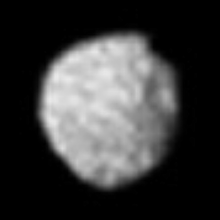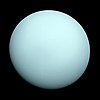Puck (moon)
 | |
| Discovery | |
|---|---|
| Discovered by | Stephen P. Synnott / Voyager 2 |
| Discovery date | December 30, 1985 |
| Designations | |
Designation | Uranus XV |
| Pronunciation | /ˈpʌk/[1] |
| Adjectives | Puckian[2] |
| Orbital characteristics | |
| 86,004.444 ± 0.064 km[3] | |
| Eccentricity | 0.00012 ± 0.000061[3] |
| 0.76183287 ± 0.000000014 d[3] | |
Average orbital speed | 8.21 km/s[a] |
| Inclination | 0.31921 ± 0.021° (to Uranus's equator)[3] |
| Satellite of | Uranus |
| Physical characteristics | |
Mean radius | 81 ± 2 km[4] |
Surface area | ~82,400 km2[a] |
| Volume | ~2,225,000 km3[a] |
| Mass | ~2.9 × 1018 kg[a] |
Mean density | ~1.3 g/cm3 (assumed) |
| 0.028 m/s2[a] | |
| 0.069 km/s[a] | |
| synchronous[4] | |
| zero[4] | |
| Albedo |
|
| Temperature | ~64 K[a] |
| 20.5[6] | |
Puck is an inner moon of Uranus. It was discovered in December 1985 by the Voyager 2 spacecraft.[7] The name Puck follows the convention of naming Uranus's moons after characters from Shakespeare. The orbit of Puck lies between the rings of Uranus and the first of Uranus's large moons, Miranda. Puck is approximately spherical in shape and has diameter of about 162 km.[4] It has a dark, heavily cratered surface, which shows spectral signs of water ice.[8]
Discovery and naming[]
Puck—the largest inner moon of Uranus—was discovered from the images taken by Voyager 2 on 30 December 1985. It was given the temporary designation S/1985 U 1.[9]
The moon was later named after the character Puck who appears in Shakespeare's A Midsummer Night's Dream, a little sprite who travels around the globe at night with the fairies. In Celtic mythology and English folklore, a Puck is a mischievous sprite, imagined as an evil demon by Christians.
It is also designated Uranus XV.[10]
Physical characteristics[]

Puck is the largest small inner moon of Uranus, which orbits inside the orbit of Miranda. It is intermediate in size between Portia (the second-largest inner moon) and Miranda (the smallest of the five large classical moons). Puck's orbit is located between the rings of Uranus and Miranda. Little is known about Puck aside from its orbit,[3] radius of about 81 km,[4] and geometric albedo in visible light of approximately 0.11.[5]
Of the moons discovered by the Voyager 2 imaging team, only Puck was discovered early enough that the probe could be programmed to image it in some detail.[7] Images showed that Puck has a shape of a slightly prolate spheroid (ratio between axes is 0.97 ± 0.04).[4] Its surface is heavily cratered[6] and is grey in color.[4] There are three named craters on the surface of Puck, the largest being about 45 km in diameter.[7] Observations with the Hubble Space Telescope and large terrestrial telescopes found water-ice absorption features in the spectrum of Puck.[5][8]
Nothing is known about the internal structure of Puck. It is probably made of a mixture of water ice with the dark material similar to that found in the rings.[8] This dark material is probably made of rocks or radiation-processed organics. The absence of craters with bright rays implies that Puck is not differentiated, meaning that ice and non-ice components have not separated from each other into a core and mantle.[7]
Named features[]

Puckian craters are named after mischievous spirits in European mythology.
| Crater | Coordinates | Diameter (km) | Approval date | Named after | Ref |
|---|---|---|---|---|---|
| 0°N 0°E / 0°N 0°E | 0 | 1988 | Bogle (Celtic) | WGPSN | |
| 0°N 0°E / 0°N 0°E | 0 | 1988 | Butz (German) | WGPSN | |
| 0°N 0°E / 0°N 0°E | 0 | 1988 | Lob (English) | WGPSN |
See also[]
- Moons of Uranus
- Rings of Uranus
- List of geological features on Puck
References[]
Explanatory notes
Citations
- ^ "Puck". Lexico UK English Dictionary. Oxford University Press. n.d.
- ^ Sedgwick (1999) Shakespeare and the young writer
- ^ a b c d e Jacobson 1998.
- ^ a b c d e f g Karkoschka, Voyager 2001.
- ^ a b c Karkoschka, Hubble 2001.
- ^ a b Thomas Veverka et al. 1987.
- ^ a b c d Smith Soderblom et al. 1986.
- ^ a b c Dumas Smith et al. 2003.
- ^ IAUC 4159.
- ^ USGS: Planet and Satellite Names and Discoverers.
Sources
- Jacobson, R. A. (1998). "The Orbits of the Inner Uranian Satellites From Hubble Space Telescope and Voyager 2 Observations". The Astronomical Journal. 115 (3): 1195–1199. Bibcode:1998AJ....115.1195J. doi:10.1086/300263.
- Karkoschka, Erich (2001). "Voyager's Eleventh Discovery of a Satellite of Uranus and Photometry and the First Size Measurements of Nine Satellites". Icarus. 151 (1): 69–77. Bibcode:2001Icar..151...69K. doi:10.1006/icar.2001.6597.
- Karkoschka, Erich (2001). "Comprehensive Photometry of the Rings and 16 Satellites of Uranus with the Hubble Space Telescope". Icarus. 151 (1): 51–68. Bibcode:2001Icar..151...51K. doi:10.1006/icar.2001.6596.
- Thomas, P.; Veverka, J.; Johnson, T.V.; Brown, Robert Hamilton (1987). "Voyager observations of 1985U1". Icarus. 72 (1): 79–83. Bibcode:1987Icar...72...79T. doi:10.1016/0019-1035(87)90121-7.
- Smith, B. A.; Soderblom, L. A.; Beebe, A.; Bliss, D.; Boyce, J. M.; Brahic, A.; Briggs, G. A.; Brown, R. H.; Collins, S. A. (4 July 1986). "Voyager 2 in the Uranian System: Imaging Science Results". Science. 233 (4759): 43–64. Bibcode:1986Sci...233...43S. doi:10.1126/science.233.4759.43. PMID 17812889.
- Dumas, Christophe; Smith, Bradford A.; Terrile, Richard J. (2003). "Hubble Space Telescope NICMOS Multiband Photometry of Proteus and Puck". The Astronomical Journal. 126 (2): 1080–1085. Bibcode:2003AJ....126.1080D. doi:10.1086/375909.
- Marsden, Brian G. (January 16, 1986). "Satellites of Uranus and Neptune". IAU Circular. 4159. Retrieved 2012-01-24.
- USGS/IAU (July 21, 2006). "Planet and Satellite Names and Discoverers". Gazetteer of Planetary Nomenclature. USGS Astrogeology. Retrieved 2012-01-24.
External links[]
| Wikimedia Commons has media related to Puck (moon). |
- Moons of Uranus
- Astronomical objects discovered in 1985
- Things named after Shakespearean works


